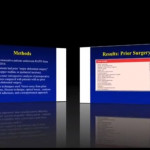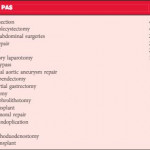Editorial: Robot-assisted partial nephrectomy: excellent outcomes can persist despite previous abdominal surgery
Robot-assisted surgery is increasing and patient selection is important to ensure mitigation of risk, patient safety and allow for the surgeon’s training curve. This is especially pertinent for robot-assisted partial nephrectomy (RAPN), as increasingly complex tumours and increasingly complex patients are considered potentially suitable. One factor that contributes to patient complexity is the presence of intra-abdominal adhesions, which can be predicted by previous abdominal surgery. This month’s article by Abdullah et al. [1] ‘Multicentre outcomes of robot-assisted partial nephrectomy after major open abdominal surgery’ eloquently describes their outcomes in patients who underwent RAPN with a history of previous open abdominal surgery.
The study retrospectively analysed 1 686 patients who had undergone RAPN from a prospective database from five large American academic institutions. A sub-group of 216 patients (13%) had undergone major prior abdominal surgery (PAS); this was defined as those marked by upper midline or ipsilateral incisions. The authors chose such incisions due to the increased potential for adhesions within the expected surgical field for RAPN, which could interfere with performance [2]. The list of prior surgeries is wide ranging such as laparotomy, open cholecystectomy, open appendicectomy and open ipsilateral PN; 12% (25 patients) had had multiple previous procedures.
The study found that there was no statistical difference between the two groups in the areas of Charlson comorbidities index, tumour size, R.E.N.A.L. nephrometry score [consists of (R)adius (tumour size as maximal diameter), (E)xophytic/endophytic properties of the tumour, (N)earness of tumour deepest portion to the collecting system or sinus, (A)nterior (a)/posterior (p) descriptor and the (L)ocation relative to the polar line], and preoperative estimated GFR. They also found no difference between intraoperative and postoperative complications (<4% Clavien ≥3 in PAS group), positive surgical margins and change in renal function.
Their initial concern that previous surgery increases robotic operative time was ill founded, as there was no statistical difference in median (interquartile range) operative times: PAS 172 (132–224) vs169 (139–208) min. However, they did find statistical difference in estimated blood loss, which was higher in the PAS group (150 vs 100 mL; P = 0.039); but this did not translate to a difference in transfusion rates.
They also found the PAS patients were older (median 63 vs 60 years) and had a higher median body mass index (30.3 vs 29 kg/m2). This is an important finding in the context of offering robotic minimally invasive surgery in an increasingly obese and ageing surgical population.
Achieving safe access is a crucial step in all laparoscopic or robot-assisted surgery and is potentially complicated by the presence of adhesions. It was of particular interest to read of the access techniques used: Hasson vs Veress needle vs retroperitoneal approach. The latter was used more in the PAS group (11.2% vs 5.4%), despite a lower percentage of posterior tumours (38.8% vs 43.3%). This suggests surgical preference for choosing a retroperitoneal approach was related to avoidance of potential adhesions rather than tumour location.
Conceptually the Hassan technique, with access achieved by direct vision, could offer safety benefits in the presence of potential adhesions; however, access via Veress needle insufflation occurred in most of their cases. The authors describe the use of the Hassan technique in instances of failure of Veress access but the incidence that this occurred is not provided. They estimated that 24 cases were converted to open due to access-related issues.
Further interrogation of the 180 open PNs performed during the study period could provide a valuable comparative group and understand why they were not deemed suitable for a robot-assisted approach.
The study can be commended for its large patient database, multicentre design, and breadth of outcomes assessed. It supports the findings of Zargar et al. [3] showing comparable perioperative complications and open conversions of RAPN in patients with and without a history of PAS in their similar sized, but single-centre study. This is also in agreement with assessments of other robotic procedures supporting the relative safety of robotic surgery in patients with a history of PAS.
One of the limitations of this study is the lack of discussion on the decision-making process for choice of access technique. Individual surgeons and/or the recommendations of multi-disciplinary teams will favour the technique with the perceived best outcome and may select out more favourable cases to each arm. Abdullah et al. [1] results may be an indication of appropriate technique selection rather than safety of the robot or individual access techniques.
This study provides robotic surgeons with increasing confidence to offer RAPN and its potential advantages of reduced blood loss, pain and recovery time to patients despite the presence of potential adhesions from PAS. Individual case selection remains imperative to maintain optimal surgical outcomes. Complex cases may be safely tackled in high-volume established RAPN programmes; but they may not be suitable for surgeons earlier in their experience. Robotic surgeons should be well trained and confident in managing the potential complications of bowel injury in these challenging cases.



